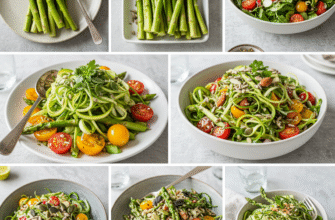Remember that perfect strawberry? The one that burst with sunshine and sweetness, staining your fingers red? Or that deeply satisfying, earthy flavor of a roasted root vegetable on a chilly evening? Chances are, those memorable bites came from produce enjoyed right smack in the middle of its natural season. We often chase exotic flavors from faraway lands or rely on year-round supermarket staples, but one of the simplest secrets to unlocking incredible taste is right under our noses: eating seasonally.
It sounds almost too simple, doesn’t it? Choosing foods that are naturally ready for harvest in your region at a particular time of year. Yet, this practice connects us to a rhythm much older than refrigerated trucking and global logistics. It’s about aligning our plates with the cycles of nature, and the rewards, especially for our taste buds, are immense.
Why Does Seasonal Taste So Much Better?
The primary reason seasonal food often tastes superior comes down to ripeness. Fruits and vegetables destined for long journeys are typically picked before they are fully ripe. This premature harvest prevents spoilage during transit and storage but comes at a significant cost to flavor development. Think about it: that final stage on the vine, bush, or tree is when the magic happens. Sugars concentrate, acids balance, and those wonderful aromatic compounds that define a fruit’s or vegetable’s unique character fully develop.
A tomato picked green and ripened with gas in a warehouse simply cannot replicate the complex, sun-drenched sweetness of one allowed to mature fully on the plant. The same applies across the board – peaches picked hard lack that luscious, dripping juiciness; berries harvested early taste watery and tart rather than intensely fruity. When produce is picked at its peak, right when nature intended, it hasn’t had to compromise its flavor potential for the sake of shelf life or transportability.
Produce harvested at its natural peak of ripeness generally contains higher levels of sugars and volatile aromatic compounds. These components are directly responsible for the intense flavor and aroma we perceive. Allowing fruits and vegetables to complete their maturation process naturally maximizes this flavor potential, something often compromised by early harvesting for long-distance shipping.
Furthermore, plants grown in their preferred season and environment tend to thrive. They get the right amount of sunlight, the ideal temperature range, and appropriate rainfall (or irrigation timed correctly). While we aren’t delving into specific nutritional science here, thriving plants generally produce more of everything that makes them taste good. The energy they absorb from the environment is channeled into creating not just size, but substance – the very essence of flavor.
The Joy of Anticipation and Variety
Eating seasonally also introduces a delightful sense of anticipation and variety into our diets. Instead of having access to everything all the time (often resulting in mediocre versions of those things), we learn to look forward to specific tastes associated with different times of the year. There’s a unique joy in that first asparagus spear of spring, the explosion of berries in summer, the hearty squashes and apples of autumn, and the robust root vegetables and citrus fruits of winter.
This natural rotation does wonders for preventing palate fatigue. When strawberries are only truly amazing for a few short weeks, you appreciate them intensely. When winter comes, you’re ready to embrace the comforting flavors of roasted parsnips and hearty greens. Each season brings its own unique palette:
- Spring: Think delicate and fresh – asparagus, peas, radishes, tender lettuces, rhubarb, early strawberries. Flavors are often green, bright, and crisp.
- Summer: Abundance and sunshine – tomatoes, cucumbers, zucchini, peppers, corn, berries, peaches, plums, melons. Flavors are sweet, juicy, and bold.
- Autumn: Earthy and comforting – squash, pumpkins, apples, pears, grapes, Brussels sprouts, mushrooms, kale. Flavors become deeper, sweeter in a different way, and more robust.
- Winter: Hardy and sustaining – root vegetables (carrots, potatoes, parsnips, turnips), citrus fruits (oranges, grapefruits, lemons), winter greens (collards, chard), onions, garlic. Flavors are often earthy, zesty, or require longer cooking to reveal their sweetness.
This constant shift keeps cooking exciting and encourages culinary exploration. You learn to work with what’s best *right now*, leading to more creative and ultimately more flavorful meals.
Finding Your Seasonal Rhythm
So, how do you tap into this flavor advantage? It’s easier than you might think.
Visit Local Markets
Farmers’ markets are the epicenter of seasonal eating. Farmers bring what they’ve just harvested, meaning it’s fresh, local, and almost certainly in season. Talk to the growers! Ask them what’s tasting best right now, how they like to prepare it. They are passionate about their produce and usually happy to share tips. You’ll often find varieties you won’t see in a supermarket, each with its own unique flavor profile.
Look at Labels (and Origins)
In the grocery store, pay attention to where produce comes from. If it’s winter in your area and you see fresh berries from halfway across the world, they likely weren’t picked yesterday at peak ripeness. Look for signage indicating “local” or “seasonal.” Prices can also be a clue; produce that’s in season locally is often more abundant and therefore less expensive.
Embrace the CSA Concept
Community Supported Agriculture (CSA) programs involve buying a “share” of a local farm’s harvest. You typically receive a box of whatever is being harvested that week. It’s a fantastic way to automatically eat seasonally, discover new vegetables, and directly support local agriculture. It forces you to cook with what’s available, pushing your culinary boundaries in the best way possible.
Consult Seasonal Food Guides
Numerous online resources and regional guides list what produce is typically in season month by month in your specific area. A quick search for “seasonal food guide [your region]” can be incredibly helpful in planning meals and shopping lists.
Cook with the Seasons
Let the season guide your cooking techniques. Summer’s bounty often shines with minimal preparation – grilling, simple salads, fresh salsas. Autumn and winter lend themselves to roasting, braising, soups, and stews, which bring out the deeper flavors of root vegetables and squashes. Using recipes designed for seasonal ingredients ensures you’re maximizing their natural taste potential.
Eating seasonally isn’t about rigid rules or deprivation. It’s about rediscovering the simple, profound pleasure of food that tastes the way it’s supposed to taste. It’s about celebrating the rhythms of the year through your meals and experiencing the peak flavor that nature provides when we align our eating with its cycles. Give it a try – your taste buds will thank you.








